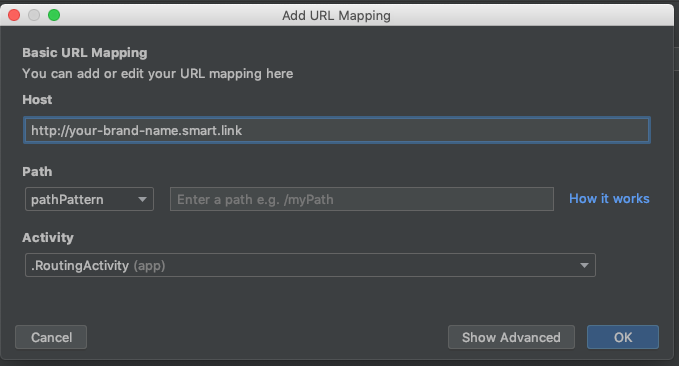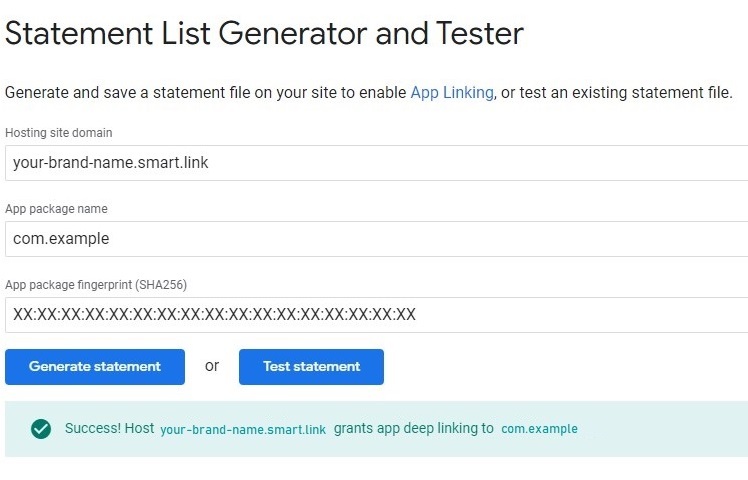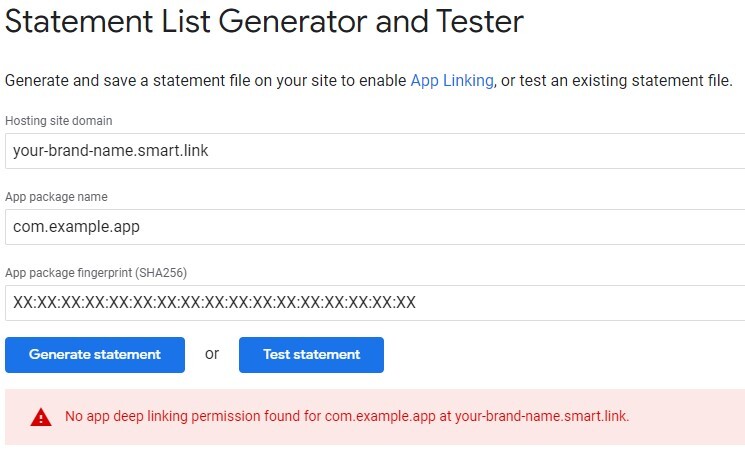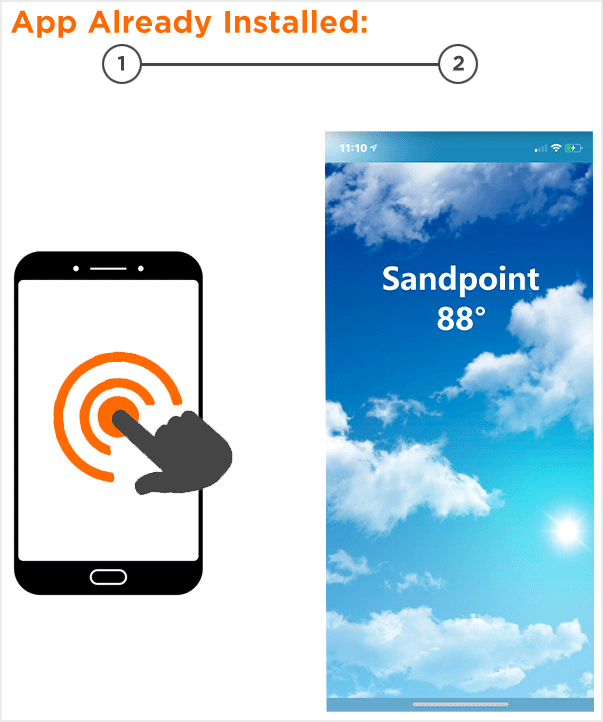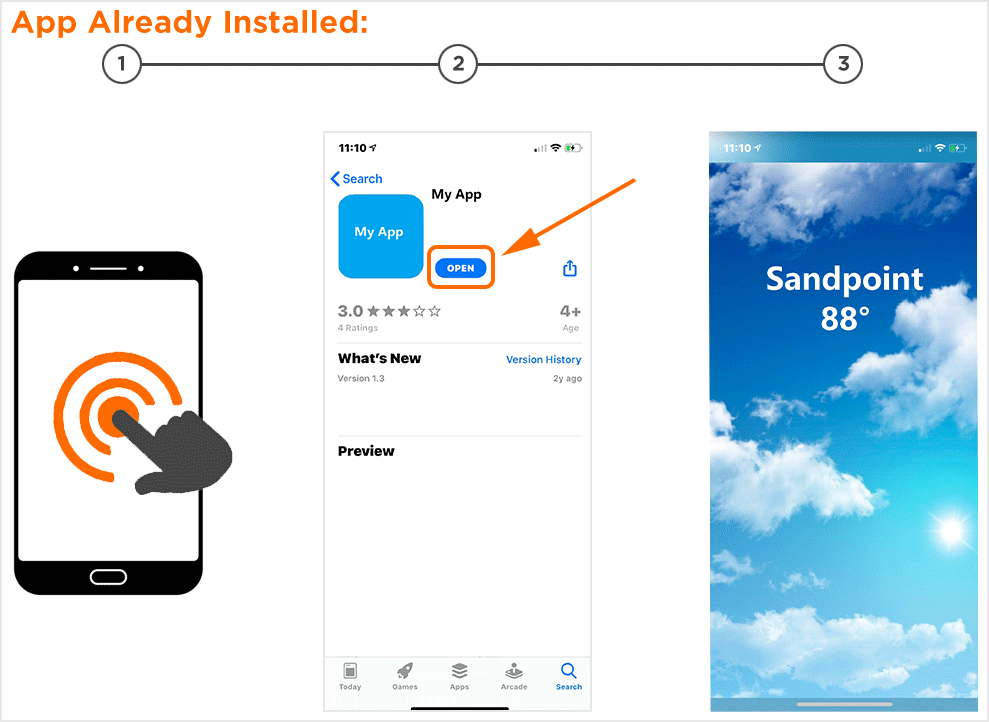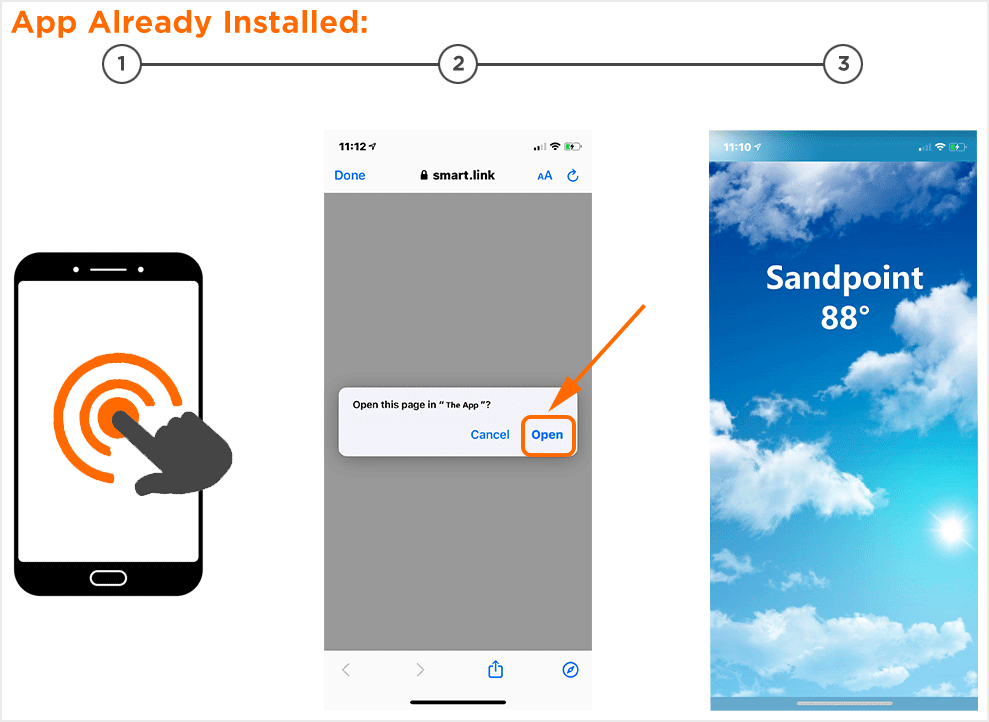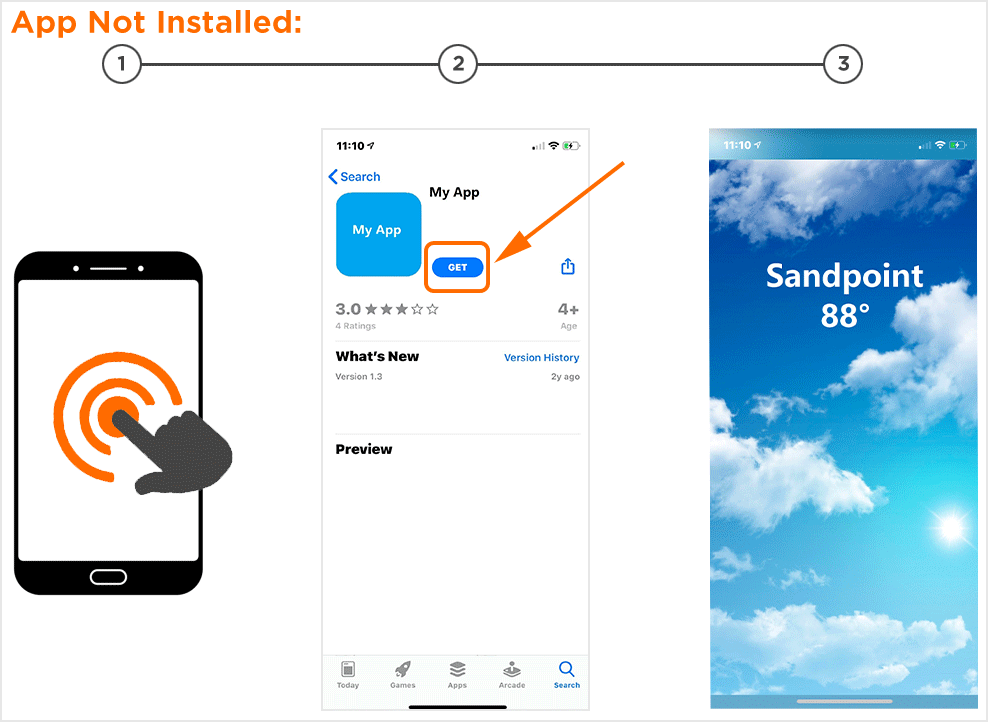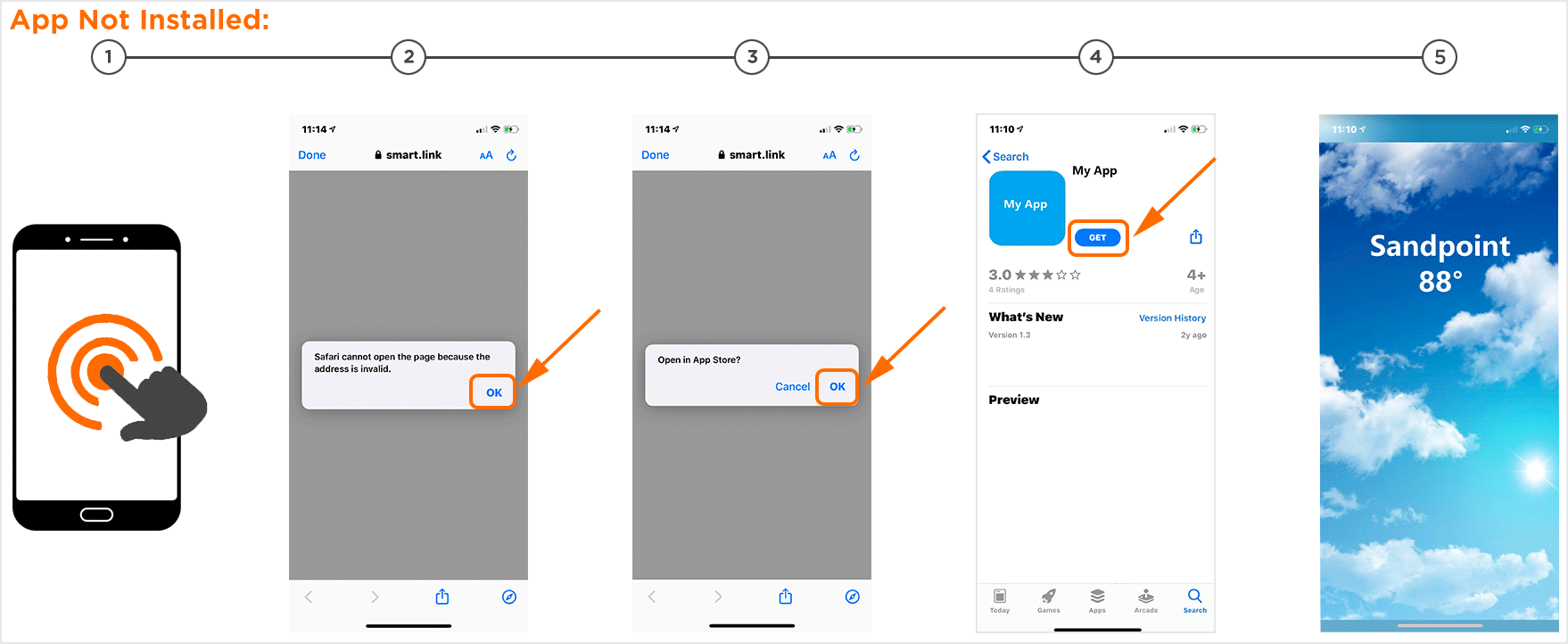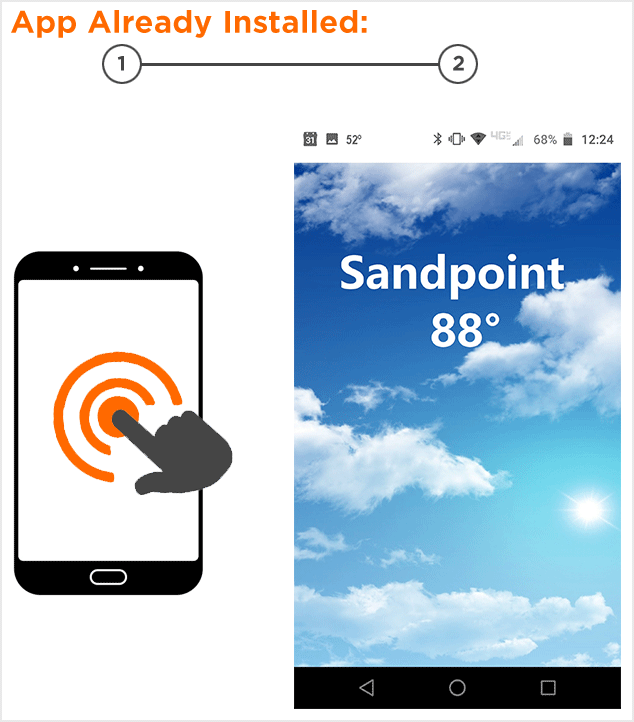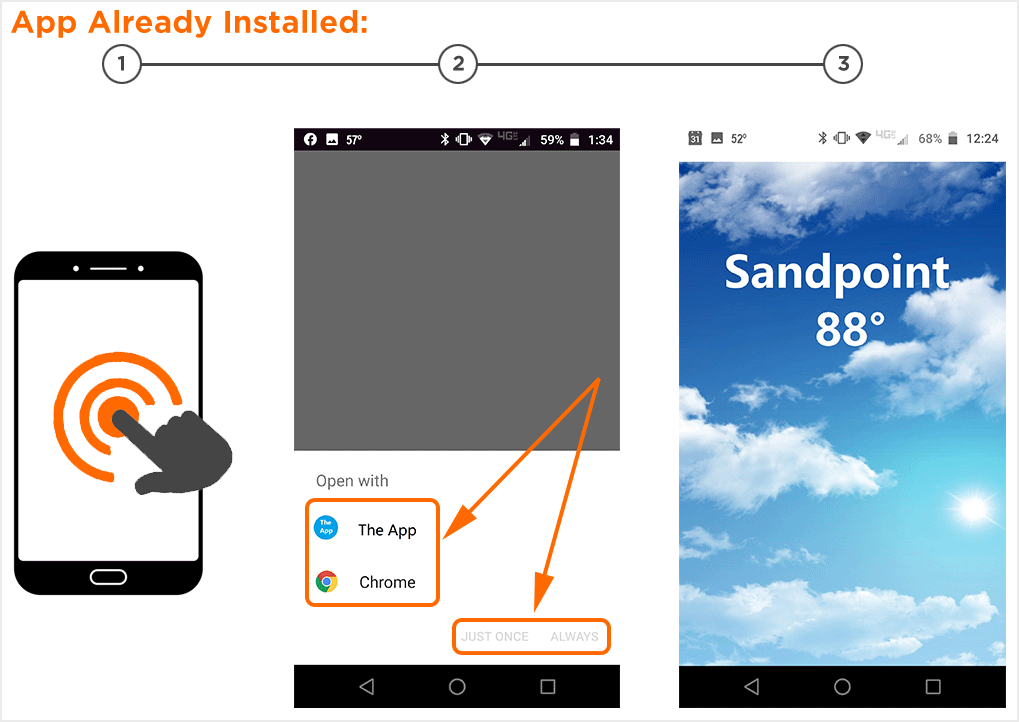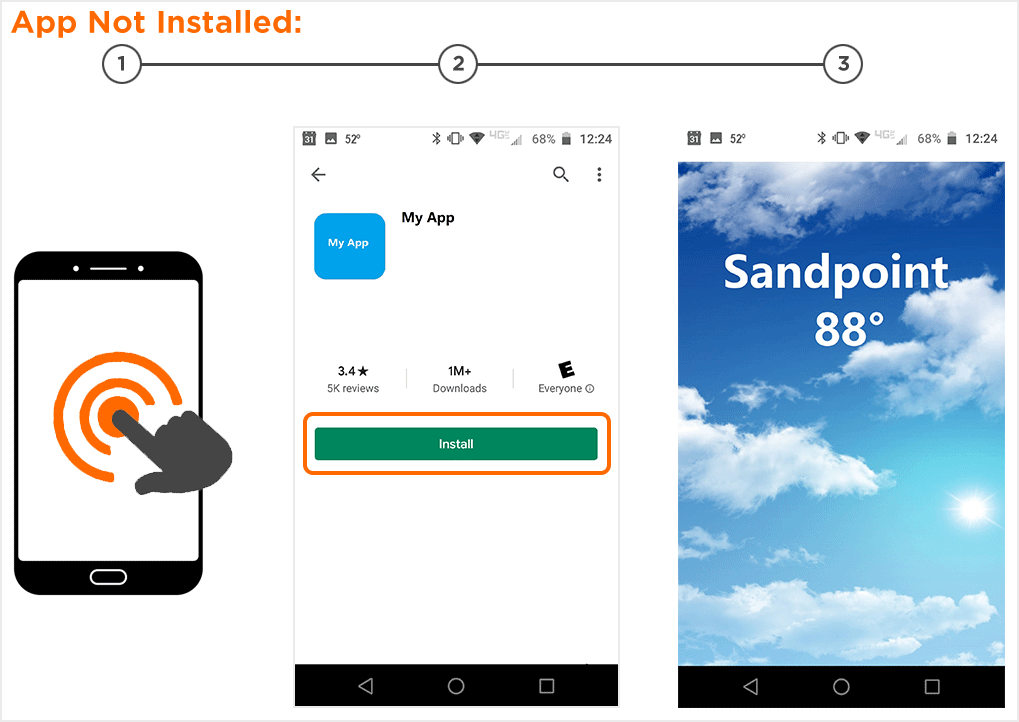NOTE: There are distinct differences in the creation of Universal Links (iOS) and App Links (Android). Where needed, specific instructions have been created for each platform.
Required Steps
- Confirm the implementation of the following minimum Kochava SDK versions or higher:
- iOS native SDK version — 3.12
- Android native SDK version — 3.7.0
- Unity — 4.1.0
- Xamarin — 3.0.0
- ReactNative — 1.3.0
- AIR — 2.5.0
- Cordova — 2.5.0
- Confirm the implementation of the Enhanced Deep Linking Kochava SDK requirements.
- Choose a custom subdomain name.
- Associate the domain to the app.
Add applinks: your-brand-name.smart.link in your com.apple.developer.associated-domains entitlement, and update your app delegate to respond appropriately when it receives the NSUserActivity object.
For more information on how to complete this step, refer to Apple’s Preparing your App to Handle Universal Links.

Add an intent filter for your-brand-name.smart.link to the activity you want to open when the link is clicked.
For information on how to complete this step using Android’s App Link Assistant, refer to Androids Create Intent Filters in your Manifest documentation.
NOTE: The below examples assume the use of an Activity named RoutingActivity but any splash or routing style activity can be used.

Using Android App Link Assistant If not using Android’s App Link Assistant, add the following (after replacing your-brand-name.smart.link) within the activity definition of your AndroidManifest.xml.
<activity android:name=".RoutingActivity" android:label="@string/title_activity_routing"> <intent-filter android:autoVerify="true"> <action android:name="android.intent.action.VIEW" /> <category android:name="android.intent.category.DEFAULT" /> <category android:name="android.intent.category.BROWSABLE" /> <data android:scheme="https" android:host="your-brand-name.smart.link" /> </intent-filter> </activity>NOTE: The Add code to your app’s activities to handle incoming links section of Android’s documentation is not needed, as this is handled by the Kochava SDK Enhanced Deep Linking functionality (Step 2 Enhanced Deep Linking).
- Create an Apple App Site Association File/Android Digital Asset Links File.
Create an Apple App Site Association File.
For more information on creating an Apple App Site Association file, refer to Apple’s Creating and Uploading the Association File support documentation.
NOTE: Simply create the file and supply it to Kochava. Kochava will upload the file to your-brand-name.smart.link domain. When a user clicks, the operating system knows to handle the link as a Universal Link and take the user directly into the app, avoiding any dialogue boxes surfaced to users.
appID: The appID in the apple-app-site-association file is the same value that is associated with the “application-identifier” key in your app’s entitlements after being built.
paths: SmartLinks have a path that is dynamic, due to the alphanumeric link ID unique to each SmartLink (your-brand-name.smart.link/{smartlinkID}. For compatibility with SmartLinks, each app included in the file should allow for all paths (“*”), as shown in the example below. There are no issues with having two or more versions of the file; one that’s used by Kochava for SmartLinks exclusively, allowing all paths, and others for non-Kochava purposes with different path settings.
If multiple apps are included, the operating system will check the apps listed top to bottom and deep link the user into the first app it detects to be present on the device.
Example of AASA File Content:
{ "applinks": { "apps": [], "details": [ { "appID": "ABCD1234.com.example.example", "paths": [ "*" ] } ] } }Create a Digital Asset Link File.
For more information on creating a Digital Asset Link file, refer to Android’s Associate Your App with Your Website support documentation.
NOTE: Simply create the file and supply it to Kochava. Kochava will upload the file to your-brand-name.smart.link domain. When a user clicks, the operating system knows to handle the link as an App Link and take the user directly into the app, avoiding any dialogue boxes surfaced to users.
handle_all_urls: SmartLinks have a path that is dynamic, due to the alphanumeric link ID unique to each SmartLink (your-brand-name.smart.link/{smartlinkID}. For compatibility with SmartLinks, each app included in the file should allow for all paths (“handle_all_urls”), as shown in the example below. There are no issues with having two or more versions of the file; one that is used by Kochava for SmartLinks exclusively, allowing all paths, and others for non-Kochava purposes with different path settings.
Example of Digital Asset Links File Content:
[ { "relation": ["delegate_permission/common.handle_all_urls"], "target": { "namespace": "android_app", "package_name": "com.xyzapp.example", "sha256_cert_fingerprints": ["XX:XX:XX:XX:XX:XX:XX:XX:XX:XX:XX:XX:XX:XX:XX:XX:XX"] } } ]- Provide the following information to your Client Success Manager:
- Your chosen custom subdomain name: your-brand-name.smart.link.
- For iOS: Your Apple App Site Association file.
- For Android: Your Digital Asset Links file.
- The iOS and Android Kochava App IDs.
- The iOS and Android Kochava Test App IDs.
- Product Name and Product Icon:
- Fallback destinations:
- iOS: Typically the app store. The iOS if app is not installed destination defined during SmartLink™ creation will override this fallback destination.
- Android: Typically the app store. The Android if app is not installed destination defined during SmartLink™ creation will override this fallback destination.
- Other: Typically your website. The if app is not installed destinations defined for other platforms or the catch-all destination defined during SmartLink™ creation will override this fallback destination.
- Wait for your Client Success Manager to confirm that your custom domain has been created.
- Once your custom domain has been created, test successful implementation of Step 4 (Associate the domain to the App)
- You can verify that the your-brand-name.smart.link has been properly associated to your app by entering your-brand-name.smart.link in Apple’s App Search API Validation Tool.
Successful

Not Successful

You can verify that there is an intent filter in place for your-brand-name.smart.link by entering your-brand-name.smart.link as the Hosting site domain, as well as the App package name and App package fingerprint (SHA256) and clicking Test statement in Google’s Statement List Generator and Tester.
Successful:

Not Successful:

- Create a test App Group that includes the test apps provided in Step 6 (Provide information to CSM).
- Create a test SmartLink™ in the App Group.
- Enter an in-app destination in the Universal Link/App Link destination if app is installed field.
- Enter if app is not installed destinations for iOS and Android (typically the app store).
- Test the SmartLink™.
Test the SmartLink™ just created by clicking it from your email app (slack works as well if it is configured to open links in safari) and confirm the following:
App is Already Installed on the Device:
The link should take you directly to the specific in-app destination (myApp://take-the-user-here in the example above).
What is happening in the Background:
- The OS checks whether the domain has permissions to take the user into the app by reading the AASA file (Step 5 Create Apple App Site Association file / Android Digital Asset Links file).
- The app is opened by the OS if the SmartLink domain was successfully added to com.apple.developer.associated-domains entitlement as a domain that your app wants to handle as Universal Link (Step 4 Associate the Domain to the App).
- The app passes the SmartLink URL to the Kochava SDK (Step 2 Confirm Implementation).
- Kochava records a click, which is made eligible for attribution to the chosen conversion events (“Level Complete” in the example above). Attribution for Kochava-hosted Universal Links is always deterministic when the app is already installed on the device.
- Kochava checks to see if there are any macros in the deep link (myApp://take-the-user-here) that could be replaced with values provided on the SmartLink URL.
- The Kochava SDK returns myApp://take-the-user-here (Step 2 Confirm Implementation).
- Alternative example: If the value included a macro, such as myApp://weather/{city}, and the SmartLink URL that drove the user into the app contained city=sandpoint, the value returned by the SDK would be myApp://weather/sandpoint.
- The app uses the information returned by the SDK (myApp://take-the-user-here) to take the user to the specific in-app destination (Step 2 Confirm Implementation).
You should not be taken to the app store where the “OPEN” button is displayed next to the app icon.
NOTE: This typically occurs when Step 4 (Associate the Domain to the App) was not completed successfully.
You should not encounter a dialogue box prompting you to choose whether you want to open in the app.
NOTE: This is expected behavior when not using a Universal Link (For example, links without a custom subdomain, such as https://smart.link/). The OS prompts the user to decide where they should be taken.
App is Not Installed on the Device:
The link should take you directly to the if app is not installed destination defined during SmartLink™ creation (typically the app store)
- You should not encounter an error dialogue box or a dialogue box prompting you to choose whether you open in the app or browser.
- This is expected behavior when not using a Universal Link (For example, links without a custom subdomain, such as https://smart.link/). The OS prompts the user to decide where they should be taken.
Test the SmartLink™ created by clicking it from your email app (slack works as well) and confirm the following scenarios
App is Already Installed on the Device:
The link should take you to the specific in-app destination (myApp://take-the-user-here in the example above).What is happening in the Background:
- The OS checks whether the domain has permissions to take the user into the app by reading the Digital Asset Links file (Step 5 Create Apple App Site Association file / Android Digital Asset Links file).
- The app is opened by the OS if the intent filter for your-brand-name.smart.link was added to AndroidManifest.xml (Step 4 Associate the Domain to the App).
- The app passes the SmartLink URL to the Kochava SDK (Step 2 Confirm Implementation).
- Kochava records a click, which is made eligible for attribution to the chosen conversion events (“Level Complete” in the example above). Attribution for Kochava-hosted App Links is always deterministic when the app is already installed on the device.
- Kochava checks to see if there are any macros in the deep link (myApp://take-the-user-here) that could be replaced with values provided on the SmartLink URL.
- The Kochava SDK returns myApp://take-the-user-here (Step 2 Confirm Implementation).
- Alternative example: If the value included a macro, such as myApp://weather/{city}, and the SmartLink URL that drove the user into the app contained city=sandpoint, the value returned by the SDK would be myApp://weather/sandpoint.
- The app uses the information returned by the SDK (myApp://take-the-user-here) to take the user to the specific in-app destination (Step 2 Confirm Implementation).
You should not encounter a dialogue box prompting you to choose whether you open in the app or in the browser.
NOTE: This typically occurs when Step 4 (Associate the Domain to the App) was not completed successfully.
App is Not Installed on the Device:
- If the expected behavior is achieved in Step 11 (Test the SmartLink™).
- Request that your Client Success Manager have your-brand-name.smart.link disassociated from the test apps and associated to your prod apps.
- Create an App Group for the production apps, if not already completed.
- Create the SmartLink™ with Universal Link/App Link Support.
iOS Enhanced Deep Linking
Android Enhanced Deep Linking
In this step, you will configure your app to pass incoming Deep Links to the Kochava SDK. Kochava will look up and respond with the final intended in-app destination of the user. The app should use this information to route the user to the appropriate destination in the app. This value is originally provided to Kochava when the SmartLink™ is created, within the Universal Link/App Link destination if app is installed field (see screenshot below).
NOTE: Please ensure that your marketing team is entering values in the below field in a format that is consistent with what your development team is expecting to receive from the SDK and are able to use it to route the user to their final destination within the app.
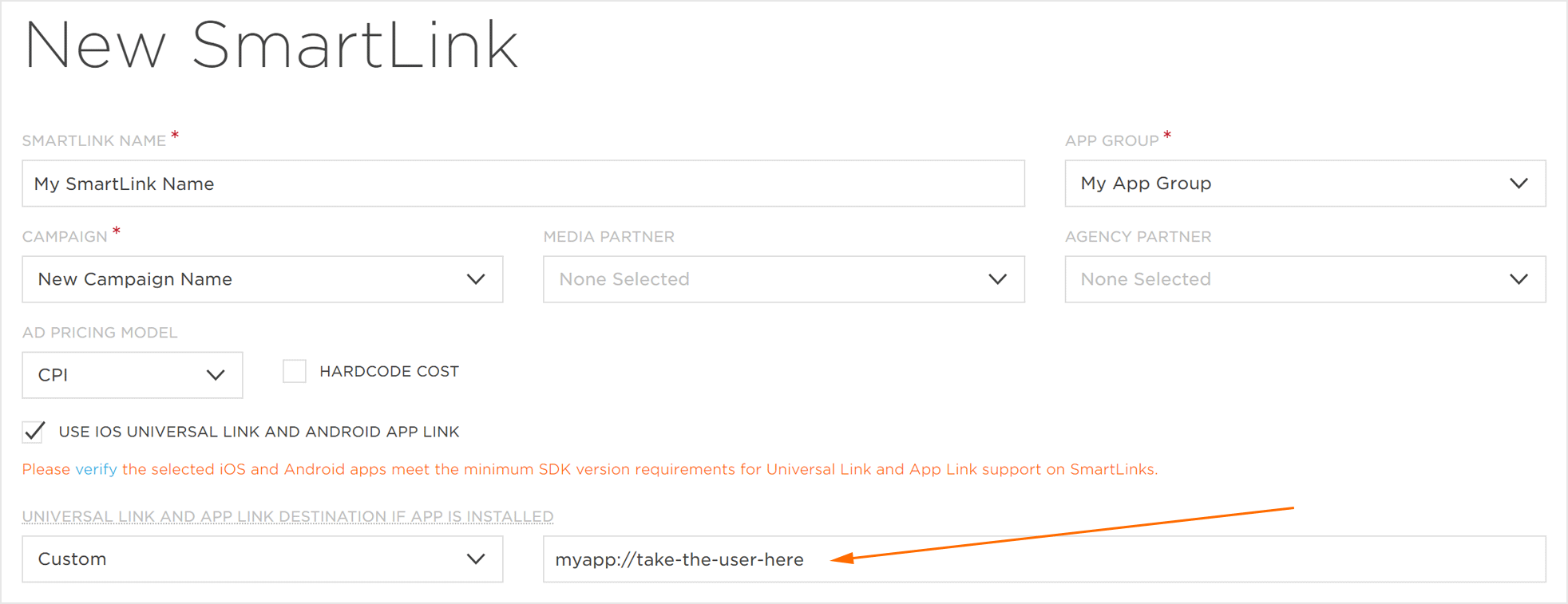
SmartLinks created will take the following format: your-brand-name.smart.link/smartlinkID
Kochava will associate your custom domain to the test apps first, allowing you to confirm the above steps were implemented correctly. Associating it to your test apps first helps avoid your team potentially creating and trafficking SmartLinks that use your custom domain before testing can be completed. If you do not have test apps, simply create new ones and supply their app IDs. Add test to the app name to help distinguish them from the prod apps.
Product Name: Typically the same as the app name on the app store and should not be platform specific.
Product Icon: Typically the same image as the app store icon. Should be a 1:1 aspect ratio (e.g., 512×512), something that works for both iOS and Android.
When a user who does not have the app installed clicks on your_brand_name.smart.link, they will be briefly auto-redirected through a web page where your product name and icon will be displayed. When using SmartLinks™, this happens on the way to the if app is not installed destination defined during SmartLink™ creation.
Your Client Success Manager can also assist you with the rest of the steps.
For more information, refer to our Creating App Groups support documentation.
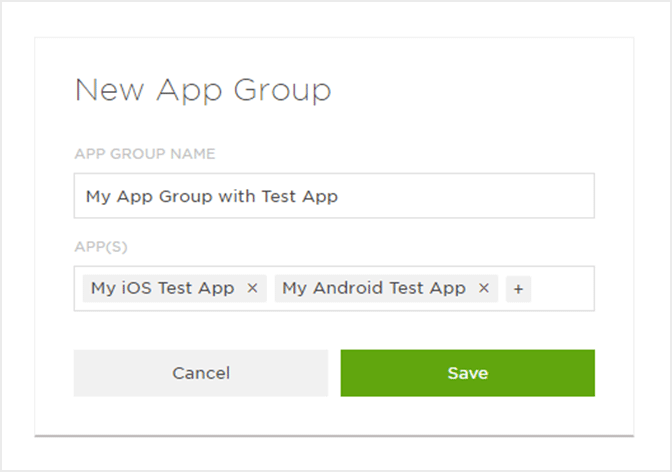
For more information, refer to our Create a SmartLink™ support documentation.
NOTE: Ensure that the value entered in this field is in a format that is consistent with what your development team is expecting to receive from the SDK and are able to use it to route the user to their final destination within the app.
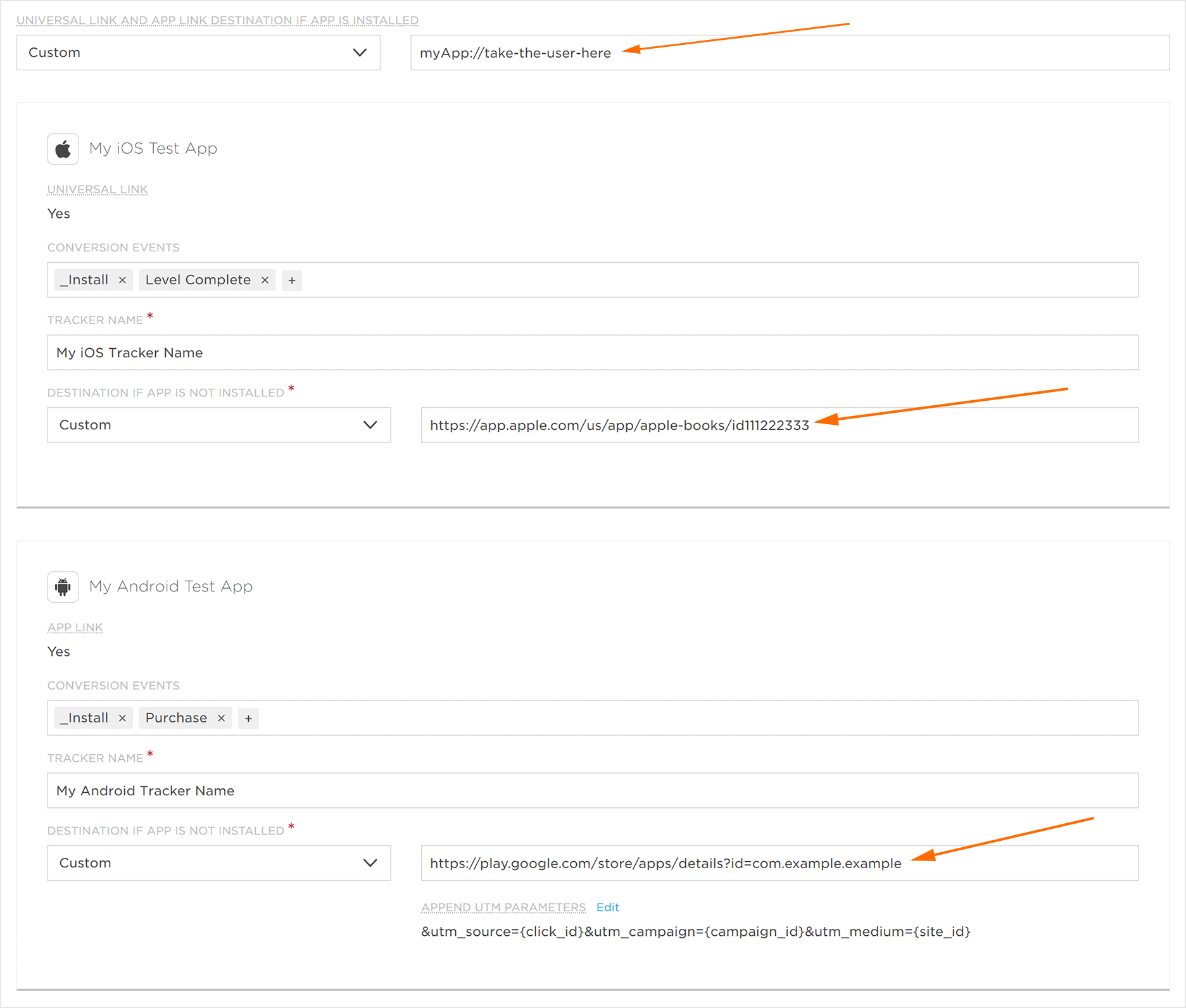
Kochava recommends archiving the SmartLink™ created for the test app group in order to avoid it accidentally getting used for live traffic.
Once you receive confirmation from your Client Success Manager, your setup is complete!
Refer to our Creating and Editing App Groups support documentation for more information.
Refer to our Creating and Editing SmartLinks™ support documentation for more information.


